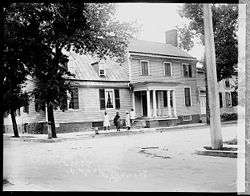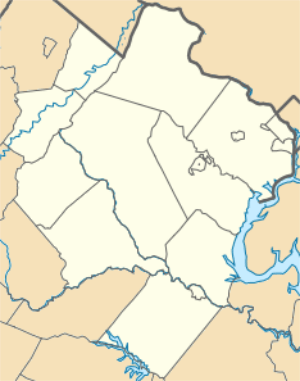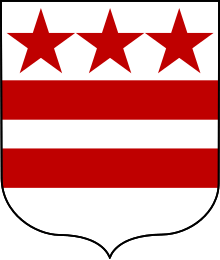Mary Ball Washington House
The Mary Washington House, at 1200 Charles Street in Fredericksburg, Virginia, is the house in which George Washington's mother, Mary Ball Washington, resided towards the end of her life. It is now operated as an 18th-century period historic house museum, one of several museums in Fredericksburg operated by Washington Heritage Museums. Today it displays 18th-century furniture, and her personal possessions, such as her "best dressing glass."
Mary Washington House | |
 Mary Washington House | |
   | |
| Location | 1200 Charles St., Fredericksburg, Virginia |
|---|---|
| Coordinates | 38°18′17″N 77°27′49″W |
| Area | 1 acre (0.40 ha) |
| Part of | Fredericksburg Historic District (ID71001053) |
| NRHP reference No. | 75002111 [1] |
| VLR No. | 111-0110 |
| Significant dates | |
| Added to NRHP | June 05, 1975 |
| Designated CP | September 22, 1971 |
| Designated VLR | March 18, 1975[2] |
History
George Washington purchased this house for his mother from Micheal Robinson in Fredericksburg, Virginia in 1772 for $275. Mary Ball Washington spent her last few years in the white frame house that sites on the corner of Charles and Lewis Street. [3] The house is located on 1200 Charles St Fredericksburg, Virginia. It was located close to her daughter Betty Washington Lewis' home, Kenmore Plantation, and close to a town home owned by her younger son Charles Washington. In 1780, Charles moved to western Virginia (present day Charles Town, West Virginia) from Fredericksburg. At that point, the house--on the town's main street--was converted into a tavern. Today, as the Rising Sun Tavern, it is open as a building museum managed by the local Washington Heritage Museums group.
Later in his life, on his visits to Fredericksburg, George Washington was a frequent visitor to his mother's home, and, in April, 1789, came to this house to receive a blessing from his mother before his inauguration.[3] A visit to Mrs. Washington in her home became a regular stop for distinguished visitors to Fredericksburg. Among those stopping by to pay their respects were John Marshall, George Mason, Thomas Jefferson, Marquis de Lafayette, and members of the Lee family. She lived in this home until her death later in 1789.
The Mary Washington House is located near the college named for her, the University of Mary Washington.
The house is currently museum for tourists to visit and view the historic landmark. Within the house itself, there is a beautiful display of Mary Washington's best ceramics. In addition, the garden is available for viewing which has been restored back to its original state after its despair. Mary was known for growing flowers and boxwoods. Tourists are able to visit the one and only 18th century outbuilding that is left, the kitchen of Mary Ball Washington's house. After visiting the house, tourists are able to go in the Mary Washington's Museum Gift Store to purchase something from one of the many collections such as teas, drinking, gardening, 18th century decorative arts, and Virginia products.
Preservation
In 1891, the Association for the Preservation of Virginia Antiquities acquired the house, which was scheduled to be disassembled for travel to the Chicago World's Fair for display. It was their second property acquisition, and the location where the Fredericksburg Branch was chartered.[3] The house underwent a restoration and was opened to the public for tours. The APVA recovered 8 objects original to the house,[3] including a mirror Mary Washington once labeled her "best dressing glass".[4] By the later Twentieth Century, APVA had become Preservation Virginia and that organization signed an agreement with the newly created and Fredericksburg-based "Washington Heritage Museums" group, to cede ownership of the property to the later group by 2013. The site is a landmark in that City.[4]
References
- "National Register Information System". National Register of Historic Places. National Park Service. March 13, 2009.
- "Virginia Landmarks Register". Virginia Department of Historic Resources. Retrieved 19 March 2013.
- Couture, Richard (1984). To Preserve and Protect. Dallas, TX: Taylor Publishing Co. p. 23. ISBN 0-917565-01-0.
- "Mary Ball Washington House". Preservation Virginia. Archived from the original on 10 June 2011. Retrieved 14 June 2011.
External links
- Washington Heritage Museums
- Preservation Virginia: Mary Washington House
- Mary Washington House, 1200 Charles Street, Fredericksburg, Fredericksburg, VA: 11 photos, 12 measured drawings, and 5 data pages at Historic American Buildings Survey


